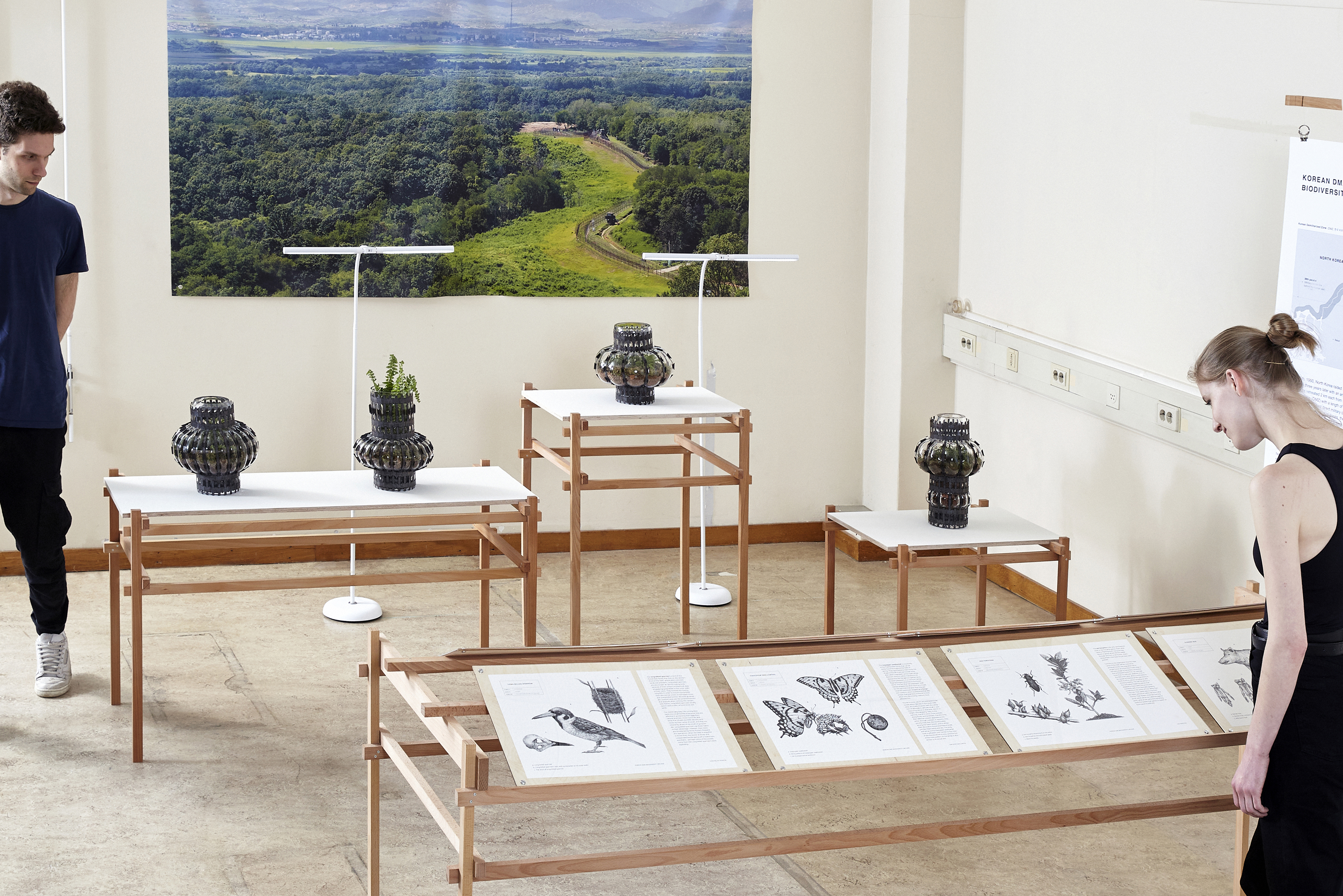폴리네이터 (2025)
The Pollinator
The Pollinator
《폴리네이터 (The Pollinator)》는 ‘초거대 녹색지대(Hyper Green Zone)’의 세계관을 확장하여 이어간다. 이번 전시는 ‘사변적 에세이’를 중심으로, 녹색지대 위를 부유하는 공중 난민촌 ‘프록시마(Proxima)’에 거주하는 주인공이 공중 생활의 어려움을 겪으며, 유한한 존재로서 무한한 바람을 탐닉하는 내용을 다룬다. 무인지대의 관점에서 하늘 공간을 조망하는 이번 시나리오는 자연의 파괴성을 은폐하는 자연에 대한 낭만적 상상력을 비판적으로 바라보며, 인간의 존재와 무관하게 지속되는 생명의 순환과 자연의 무심한 흐름에 주목한다. 이는 무인지대의 생태계가 자연의 파괴성을 실감하고 인간의 유한성을 깨닫게 하는 교훈적 공간으로 인식되어야 함을 강조하며, 자연에 대한 인간의 인식과 실재하는 자연 사이의 간극을 조명한다.
-
‘The Pollinator’ extends the world of the ‘Hyper Green Zone’ universe. At the heart of the exhibition is a speculative essay that follows a protagonist residing in Proxima, an aerial refugee settlement drifting above the green zone. The narrative explores the hardships of sky-bound life and the protagonist’s yearning for the infinite, despite their finite existence. From the perspective of an uninhabited zone, the scenario contemplates aerial space while critically reflecting on the romanticized vision of nature that masks its inherent destructiveness. It draws attention to the ceaseless cycle of life and the indifferent flow of nature that persist regardless of human presence. The uninhabited zone is presented as a didactic space—one that renders nature’s destructive force tangible and evokes an awareness of human finitude. Ultimately, the work illuminates the gap between how humans perceive nature and how nature truly exists.
Site menu의 ‘The Pollinator’ 페이지에서 사변적 에세이, ‘어느 프록시마인의 에세이'를 감상하실 수 있습니다.
You can read the full speculative essay, ‘An Essay by a Proximan’, on the ‘The Pollinator’ page in the site menu.
-
‘The Pollinator’ extends the world of the ‘Hyper Green Zone’ universe. At the heart of the exhibition is a speculative essay that follows a protagonist residing in Proxima, an aerial refugee settlement drifting above the green zone. The narrative explores the hardships of sky-bound life and the protagonist’s yearning for the infinite, despite their finite existence. From the perspective of an uninhabited zone, the scenario contemplates aerial space while critically reflecting on the romanticized vision of nature that masks its inherent destructiveness. It draws attention to the ceaseless cycle of life and the indifferent flow of nature that persist regardless of human presence. The uninhabited zone is presented as a didactic space—one that renders nature’s destructive force tangible and evokes an awareness of human finitude. Ultimately, the work illuminates the gap between how humans perceive nature and how nature truly exists.
Site menu의 ‘The Pollinator’ 페이지에서 사변적 에세이, ‘어느 프록시마인의 에세이'를 감상하실 수 있습니다.
You can read the full speculative essay, ‘An Essay by a Proximan’, on the ‘The Pollinator’ page in the site menu.

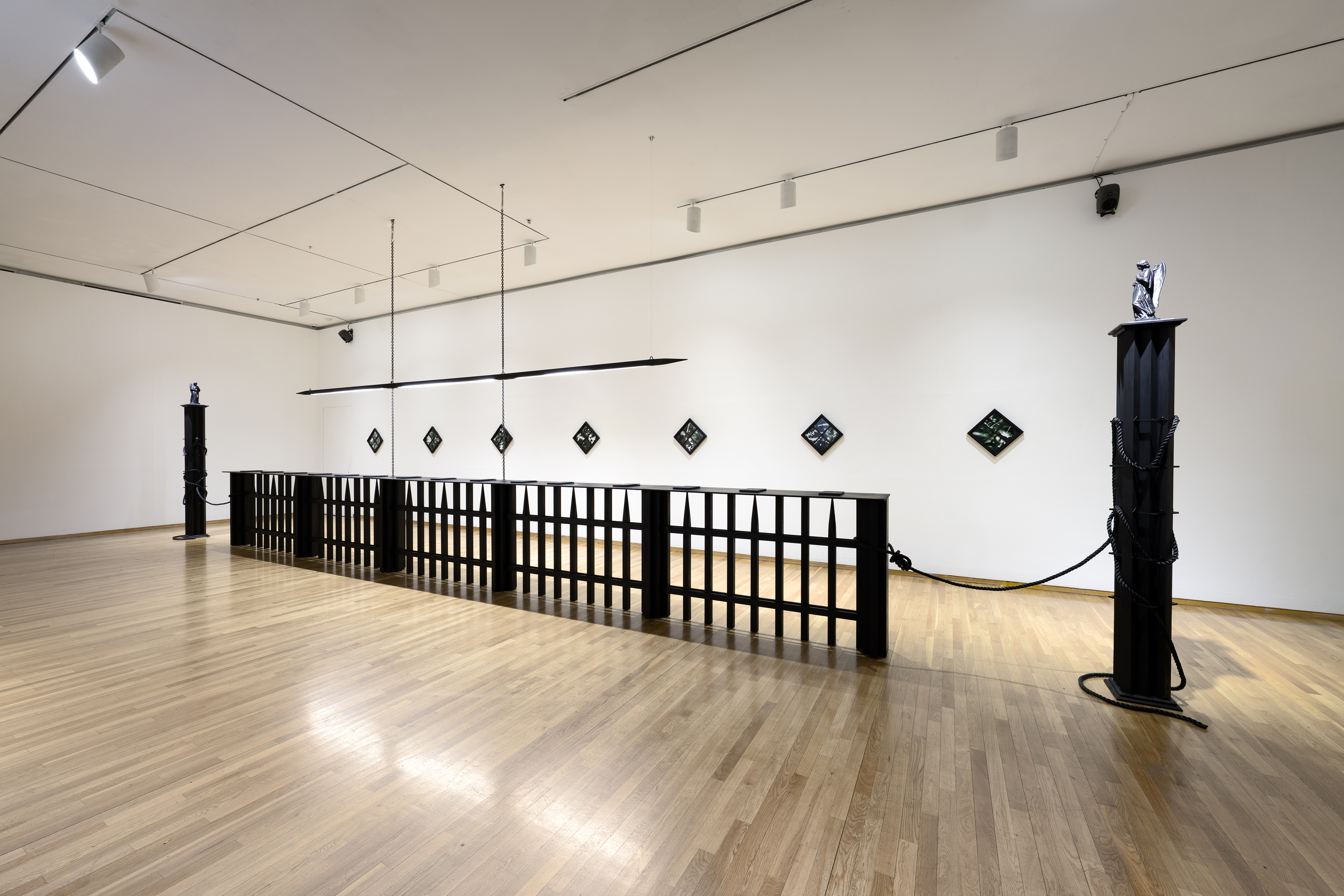

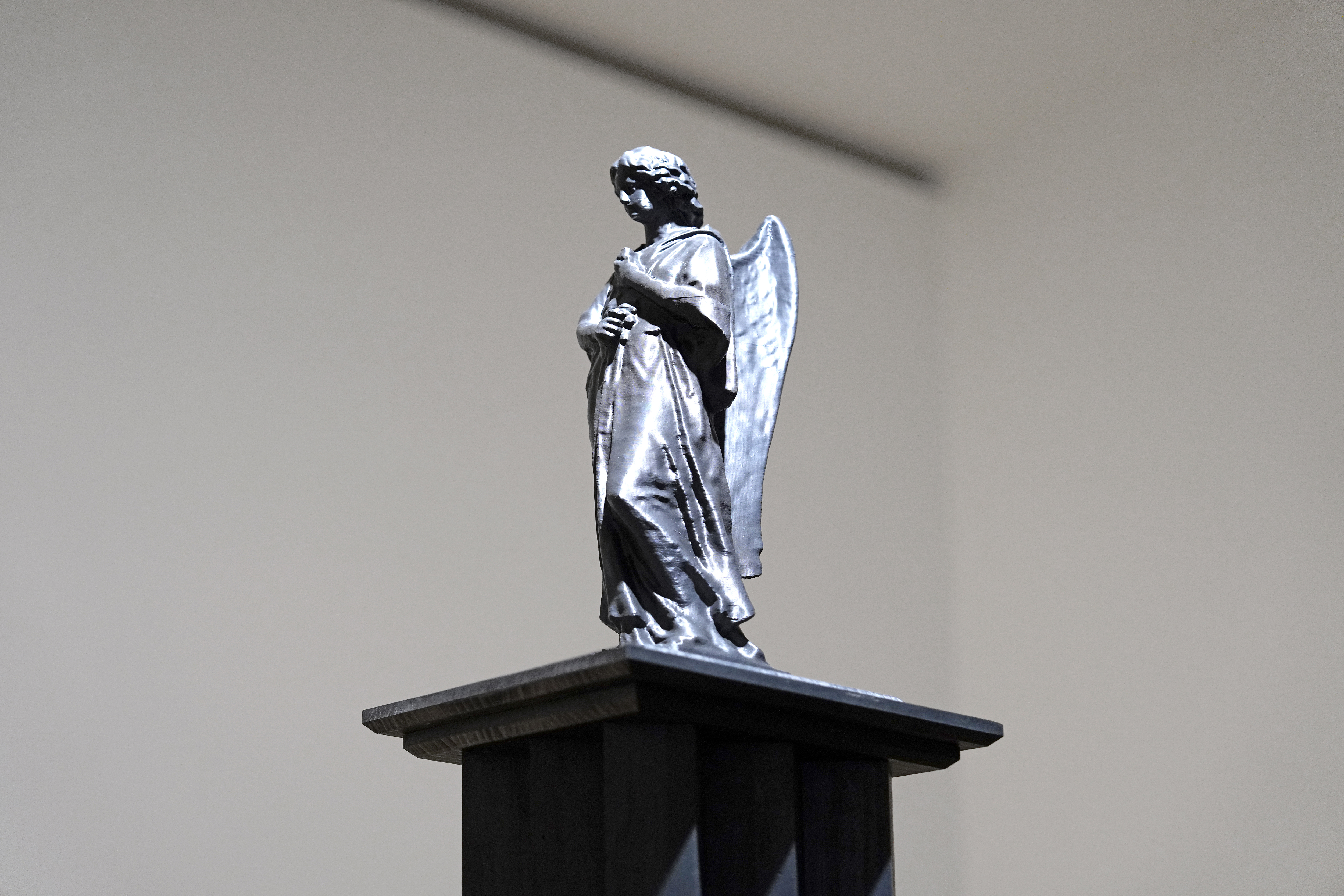
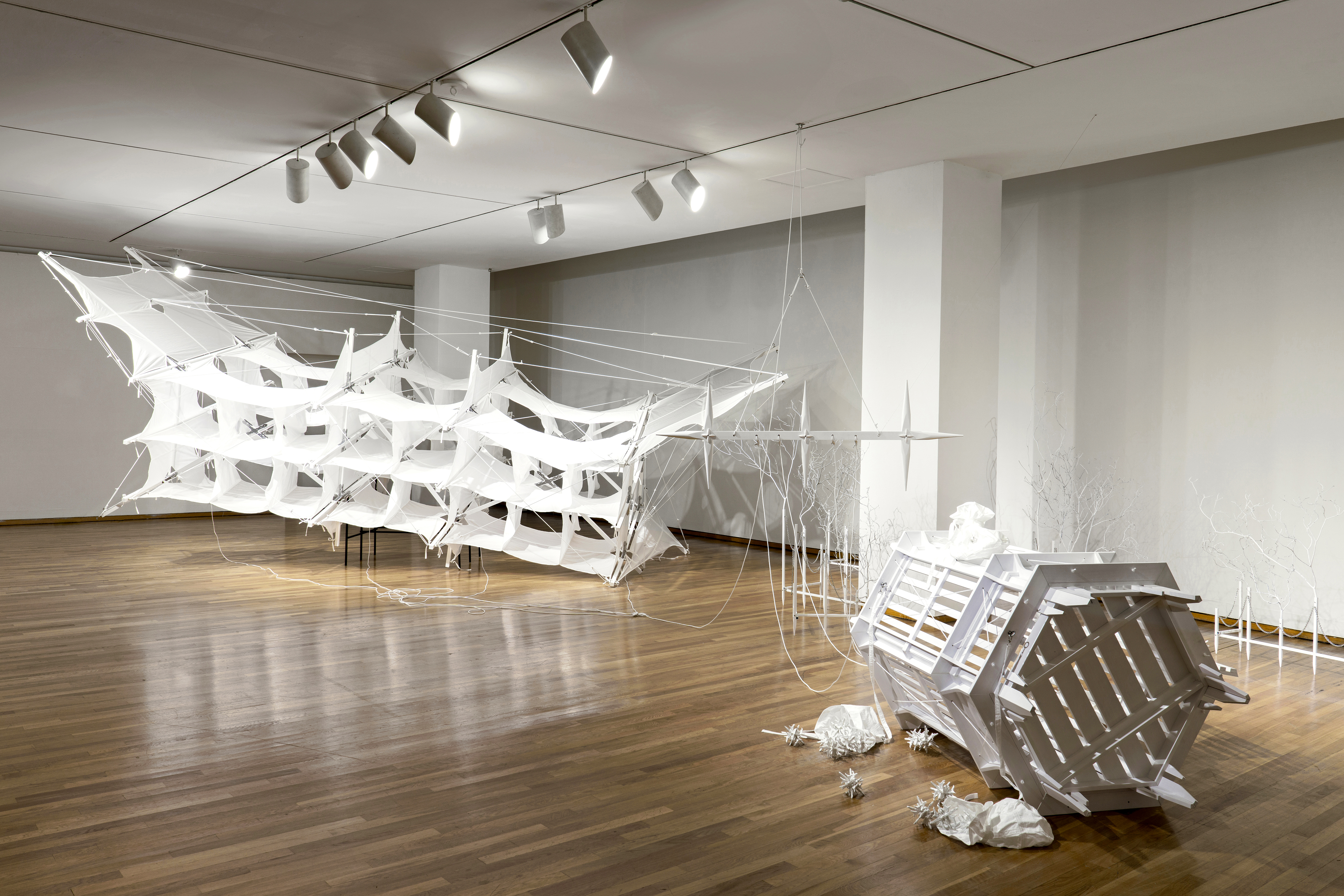

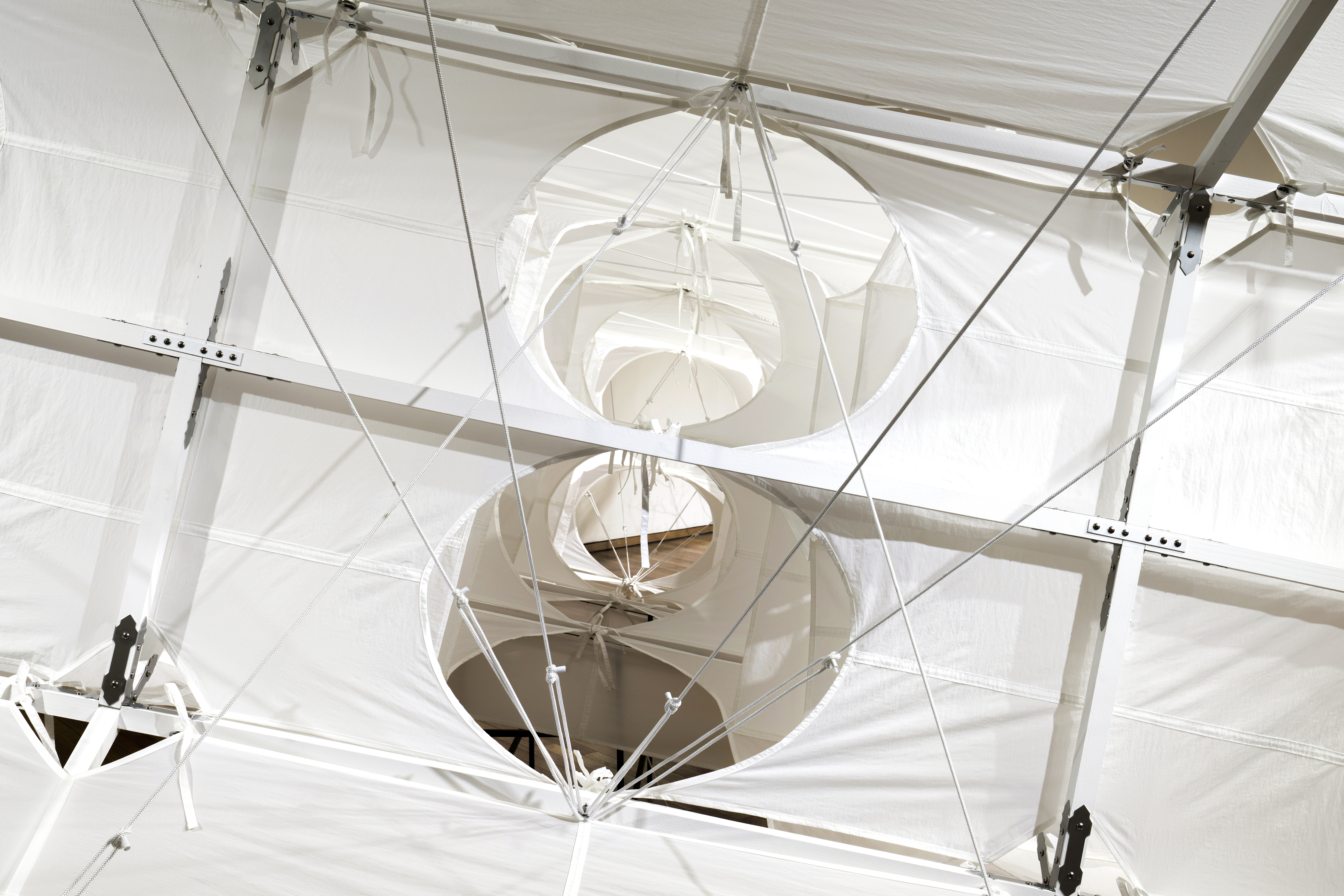

초거대 녹색지대 (2024)
Hyper Green Zone
Hyper Green Zone
팬데믹 이후 우리는 인류가 조성한 지구 생태계의 균열이 재앙으로 다시 돌아온 상황을 목격하며 인간이 결코 자연과 분리될 수 없는 존재임을 깨닫게 되었다. 하지만 아이러니하게도 인간과 분리된 자연은 오늘날 이상적 자연의 원형으로 환상화되고 있다. 과연 우리는 인간이 사라진 자연을 이상적으로만 바라볼 수 있을까? 한국 비무장지대(DMZ), 체르노빌(CEZ), 후쿠시마(FEZ)에 이르는 현대의 무인지대(No man’s land)는 전쟁 무기와 방사능과 같은 폭력적 객체들이 서식하는 위험 구역으로 그 이상적 자연이 폭력에 의해 성취될 수 있음을 방증한다.
《초거대 녹색지대 (HYPER GREEN ZONE)》는 위협적인 녹색지대에 고립된 인류의 디스토피아적인 미래 시대를 통해, 현대의 무인지대에서 통찰한 자연 개념의 섬뜩함과 모순적 이면을 극적으로 연출한다. 전시는 해당 시대에서 발견된 7가지의 상상적 사물들을 역사박물관의 형식으로 소개하며, 각각의 사물은 다양한 관점에서 바라본 시대의 비극적 단면들을 기록한다. 녹색의 의미가 위협과 공포로 전복된 ‘초거대 녹색지대’의 세계관은 이상적 자연으로 상징되는 손 닿지 않은 자연에 의한 아포칼립스로 관람객들을 초대하며, 인간과 자연 사이의 이원론에 대한 해체와 이상적 자연에 대한 재정의를 호소한다.
-
After the pandemic, we witnessed how the ruptures in the Earth’s ecosystem—caused by human activity—returned as disaster, revealing that humanity can never be separate from nature. Yet, paradoxically, nature apart from humans is now romanticized as an idealized form. But can we truly view a world without humans as purely idyllic? Modern-day no man’s lands—such as the Korean DMZ, Chernobyl (CEZ), and Fukushima (FEZ)—are zones of extreme danger, inhabited by violent remnants like military weapons and radiation. These spaces demonstrate that so-called ‘ideal’ nature can, in fact, be realized through destruction and violence.
‘Hyper Green Zone’ envisions a dystopian future where humanity is isolated within a threatening green expanse. Drawing from the unsettling contradictions observed in these uninhabited zones, the exhibition presents a dramatic portrayal of nature as both sublime and menacing. Structured like a historical museum, the exhibition showcases seven fictional artifacts discovered from this future era. Each artifact documents a tragic facet of the time, offering multifaceted perspectives on the collapse of human-nature relations. By subverting the meaning of green into one of fear and danger, Hyper Green Zone invites viewers into an apocalyptic world shaped by untouched nature. It challenges the binary view of humans versus nature and urges a critical redefinition of the ‘ideal’ natural world.
Site menu의 ‘Hyper Green Zone’ 페이지에서 7가지 상상적 사물에 대한 시나리오 전문을 감상하실 수 있습니다. You can read the full scenarios of the seven fictional artifacts on the ‘Hyper Green Zone’ page in the site menu.
《초거대 녹색지대 (HYPER GREEN ZONE)》는 위협적인 녹색지대에 고립된 인류의 디스토피아적인 미래 시대를 통해, 현대의 무인지대에서 통찰한 자연 개념의 섬뜩함과 모순적 이면을 극적으로 연출한다. 전시는 해당 시대에서 발견된 7가지의 상상적 사물들을 역사박물관의 형식으로 소개하며, 각각의 사물은 다양한 관점에서 바라본 시대의 비극적 단면들을 기록한다. 녹색의 의미가 위협과 공포로 전복된 ‘초거대 녹색지대’의 세계관은 이상적 자연으로 상징되는 손 닿지 않은 자연에 의한 아포칼립스로 관람객들을 초대하며, 인간과 자연 사이의 이원론에 대한 해체와 이상적 자연에 대한 재정의를 호소한다.
-
After the pandemic, we witnessed how the ruptures in the Earth’s ecosystem—caused by human activity—returned as disaster, revealing that humanity can never be separate from nature. Yet, paradoxically, nature apart from humans is now romanticized as an idealized form. But can we truly view a world without humans as purely idyllic? Modern-day no man’s lands—such as the Korean DMZ, Chernobyl (CEZ), and Fukushima (FEZ)—are zones of extreme danger, inhabited by violent remnants like military weapons and radiation. These spaces demonstrate that so-called ‘ideal’ nature can, in fact, be realized through destruction and violence.
‘Hyper Green Zone’ envisions a dystopian future where humanity is isolated within a threatening green expanse. Drawing from the unsettling contradictions observed in these uninhabited zones, the exhibition presents a dramatic portrayal of nature as both sublime and menacing. Structured like a historical museum, the exhibition showcases seven fictional artifacts discovered from this future era. Each artifact documents a tragic facet of the time, offering multifaceted perspectives on the collapse of human-nature relations. By subverting the meaning of green into one of fear and danger, Hyper Green Zone invites viewers into an apocalyptic world shaped by untouched nature. It challenges the binary view of humans versus nature and urges a critical redefinition of the ‘ideal’ natural world.
Site menu의 ‘Hyper Green Zone’ 페이지에서 7가지 상상적 사물에 대한 시나리오 전문을 감상하실 수 있습니다. You can read the full scenarios of the seven fictional artifacts on the ‘Hyper Green Zone’ page in the site menu.
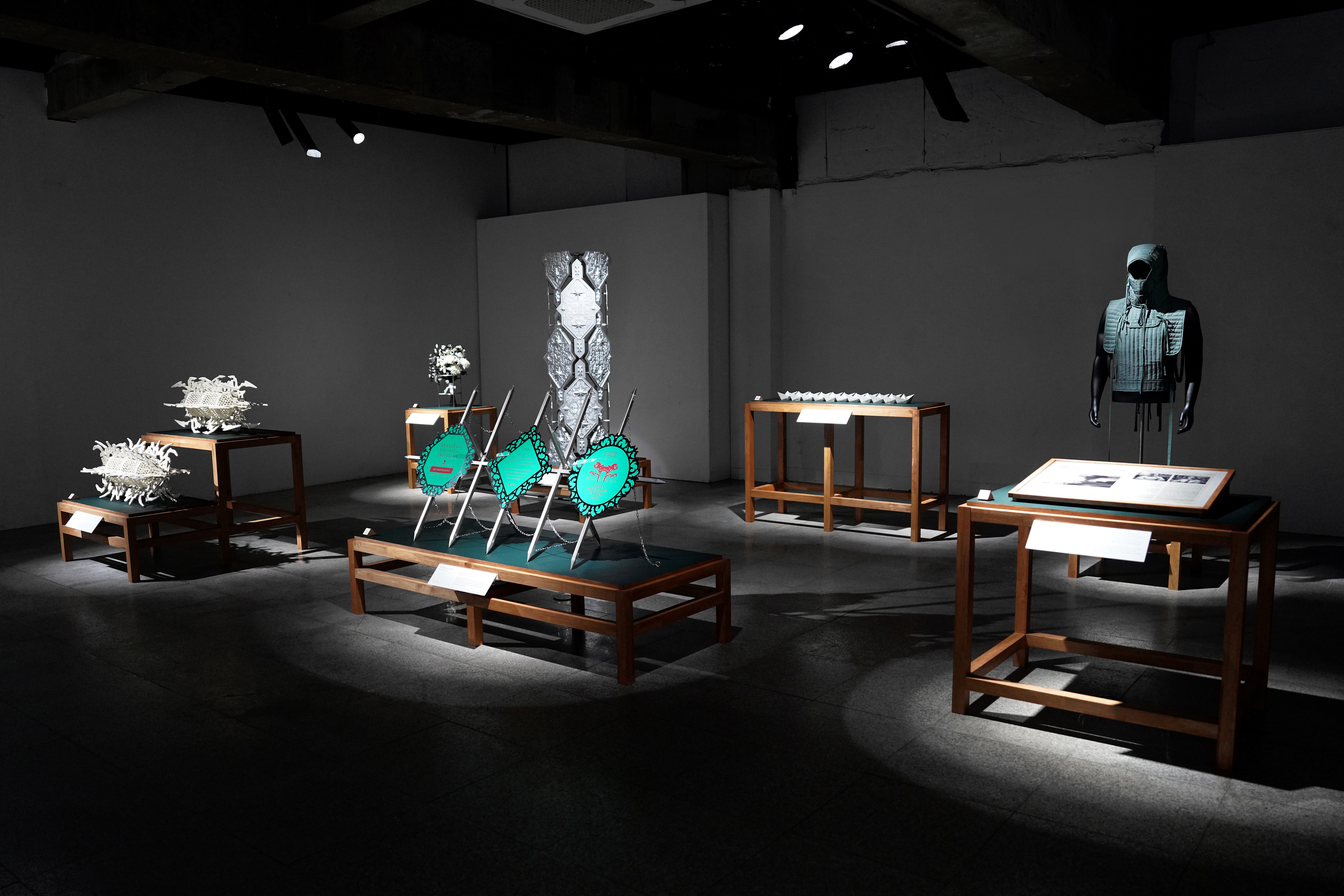

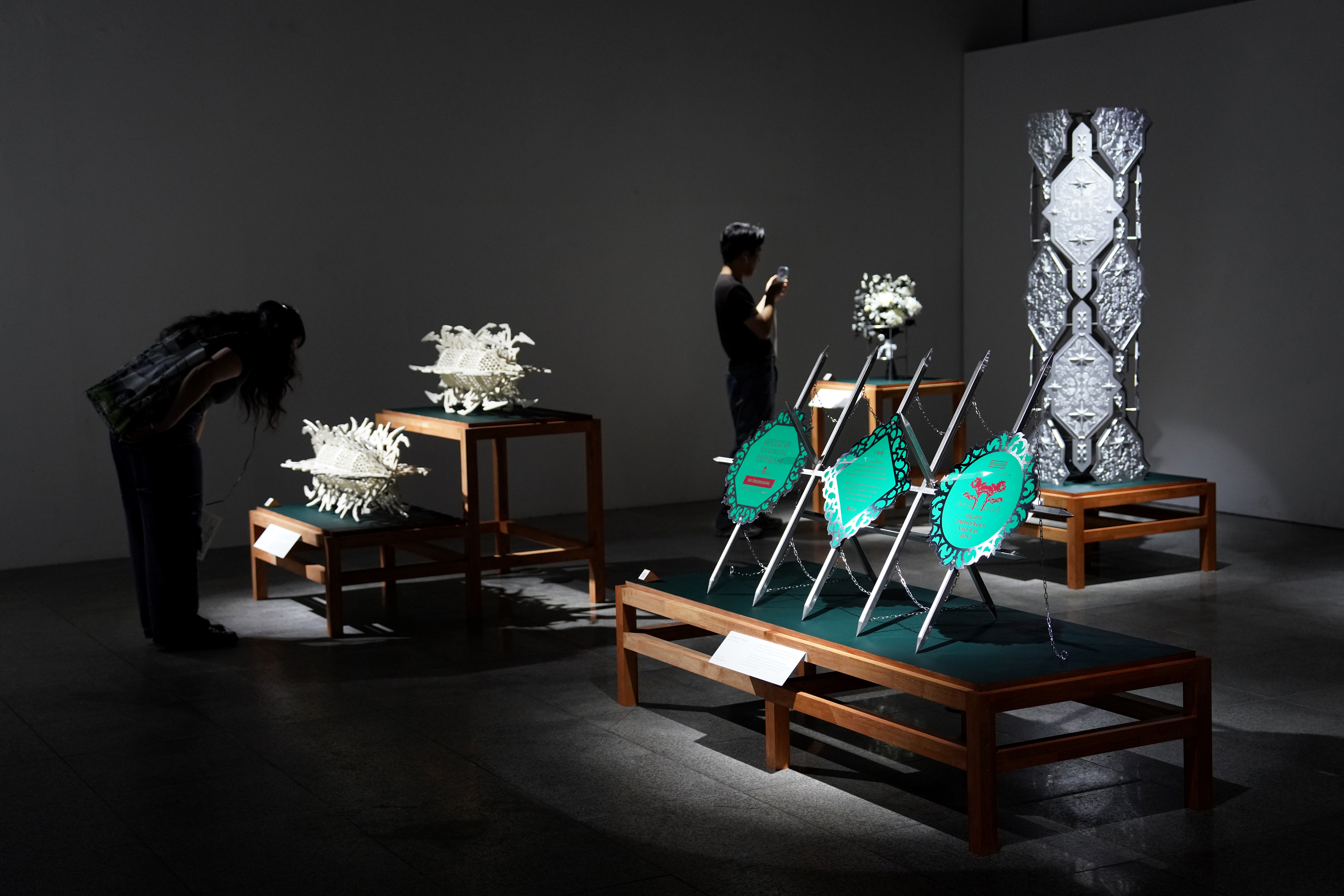
진열장의 사물들 (2024)
Showcased Objects
Showcased Objects
진열장에 가지런히 놓인 사물들이 고객들의 소비를 유혹할 채비를 마치고 침묵과 함께 대기 중이다. 특가 할인이 적힌 가격표와 품질을 인증하는 마크가 곁에서 그들의 유혹을 조력하고 있다. 하지만 그것들을 유심히 바라보니 그 생김새가 곤충과 식물 따위의 생물 표본과 흡사하다. 송장처럼 기능을 잃고 차갑게 식어버린 껍데기 사물들이 전족 작업을 마친 곤충 표본처럼 바닥에 규칙적으로 고정되어 있다.
그것들은 비록 죽어있지만 소비를 통해 단순히 소유되고 착취당하는 인간과의 피지배 관계에서 탈피하여 생물과 동등한 지위와 자격을 얻은 것처럼 당당해 보인다. 혹스(Hox) 유전자를 가진 양향 동물들(Bilateria)처럼 좌우대칭을 한 사물들이 진열된 이 변종적인 모습의 쇼케이스 디스플레이는 인류세 이후 자연과 인공을 구분하는 것의 무의미와 실로 권위적이며 생동적인 사물의 위엄을 동시에 기리는 기념비 같아 보이기도 한다. 반면 특정한 시간대와 장소의 증거가 되는 표본의 관점에서 이것들은 사물 생태계의 생태적 일원으로 공생하는 인류의 현주소를 표상하는 듯하다. 또한 미래의 진화를 예측하는 데이터로도 활용되는 표본의 또 다른 기능적 관점에서 이 하이브리드는 ‘과연 비인간 생물과 사물 중 무엇이 오늘날 인류의 진화를 결정하는가?’라는 질문을 불러일으킨다.
-
Neatly arranged in a display case, the objects stand in silence, poised to entice consumers. Price tags touting discounts and quality seals assist in their appeal. But on closer inspection, they resemble biological specimens—like insects or plants. Cold and functionless like corpses, these shell-like forms lie pinned in neat rows, echoing bound insect specimens.
Though lifeless, they seem oddly dignified—as if they have freed themselves from subjugation and gained a status equal to living organisms. This mutated showcase resembles a monument—celebrating both the collapse of the boundary between nature and artificiality, and the latent power of objects themselves. Viewed as specimens tied to time and place, they reflect humanity’s current state of coexistence in an object ecology. And from another angle—as data used to anticipate future evolution—this hybrid display raises a provocative question: “What drives human evolution today—nonhuman life, or the objects we create?”
그것들은 비록 죽어있지만 소비를 통해 단순히 소유되고 착취당하는 인간과의 피지배 관계에서 탈피하여 생물과 동등한 지위와 자격을 얻은 것처럼 당당해 보인다. 혹스(Hox) 유전자를 가진 양향 동물들(Bilateria)처럼 좌우대칭을 한 사물들이 진열된 이 변종적인 모습의 쇼케이스 디스플레이는 인류세 이후 자연과 인공을 구분하는 것의 무의미와 실로 권위적이며 생동적인 사물의 위엄을 동시에 기리는 기념비 같아 보이기도 한다. 반면 특정한 시간대와 장소의 증거가 되는 표본의 관점에서 이것들은 사물 생태계의 생태적 일원으로 공생하는 인류의 현주소를 표상하는 듯하다. 또한 미래의 진화를 예측하는 데이터로도 활용되는 표본의 또 다른 기능적 관점에서 이 하이브리드는 ‘과연 비인간 생물과 사물 중 무엇이 오늘날 인류의 진화를 결정하는가?’라는 질문을 불러일으킨다.
-
Neatly arranged in a display case, the objects stand in silence, poised to entice consumers. Price tags touting discounts and quality seals assist in their appeal. But on closer inspection, they resemble biological specimens—like insects or plants. Cold and functionless like corpses, these shell-like forms lie pinned in neat rows, echoing bound insect specimens.
Though lifeless, they seem oddly dignified—as if they have freed themselves from subjugation and gained a status equal to living organisms. This mutated showcase resembles a monument—celebrating both the collapse of the boundary between nature and artificiality, and the latent power of objects themselves. Viewed as specimens tied to time and place, they reflect humanity’s current state of coexistence in an object ecology. And from another angle—as data used to anticipate future evolution—this hybrid display raises a provocative question: “What drives human evolution today—nonhuman life, or the objects we create?”

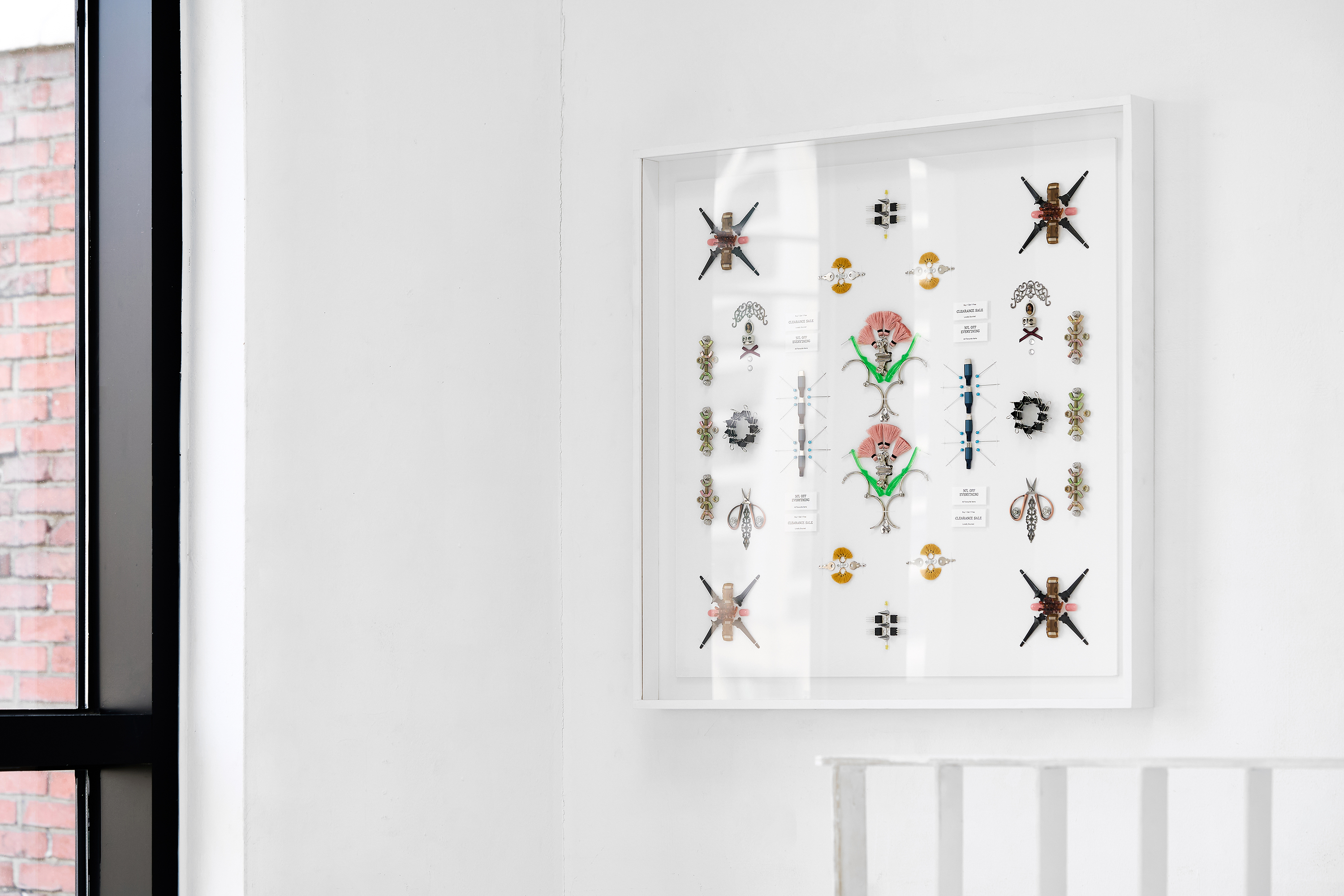






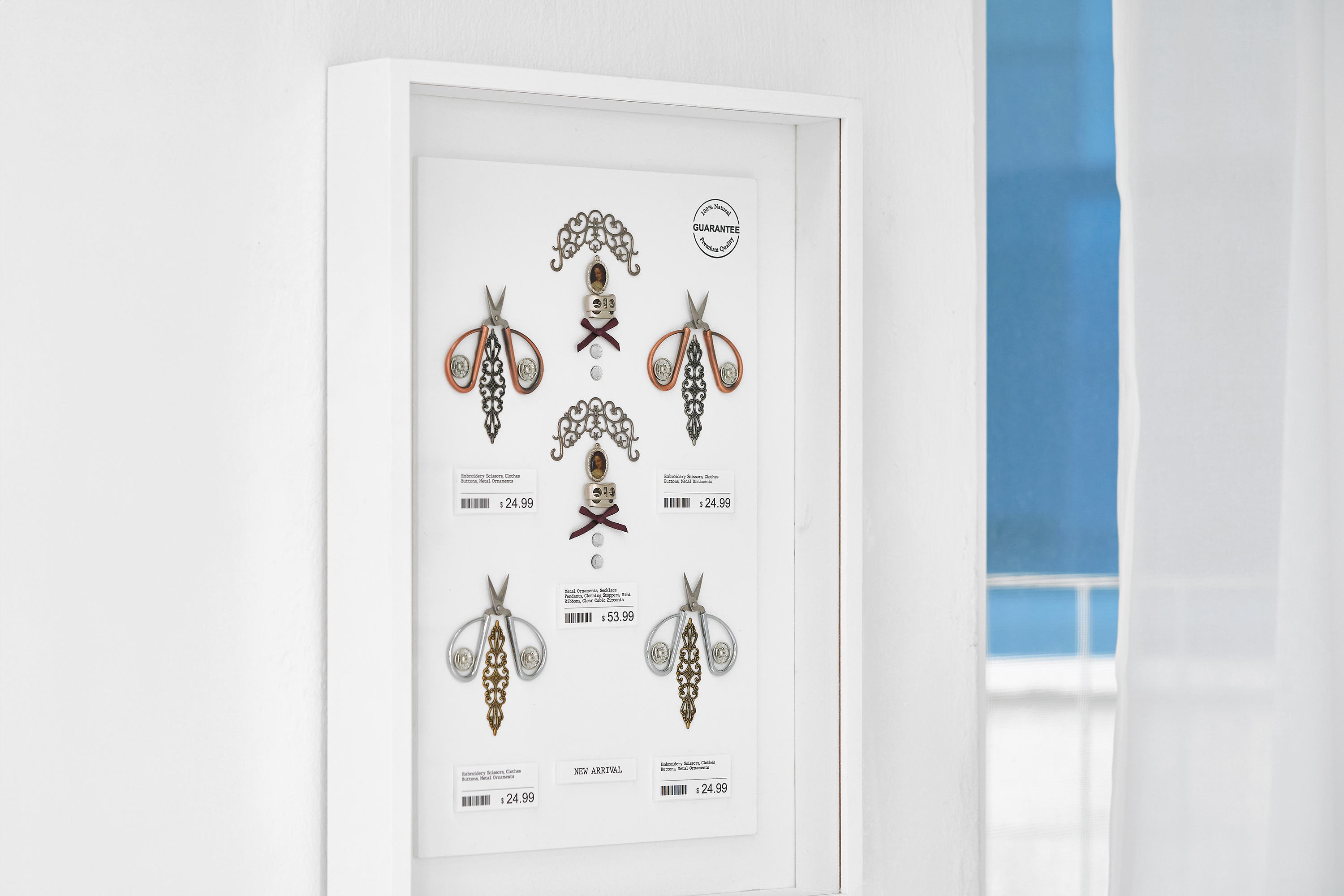

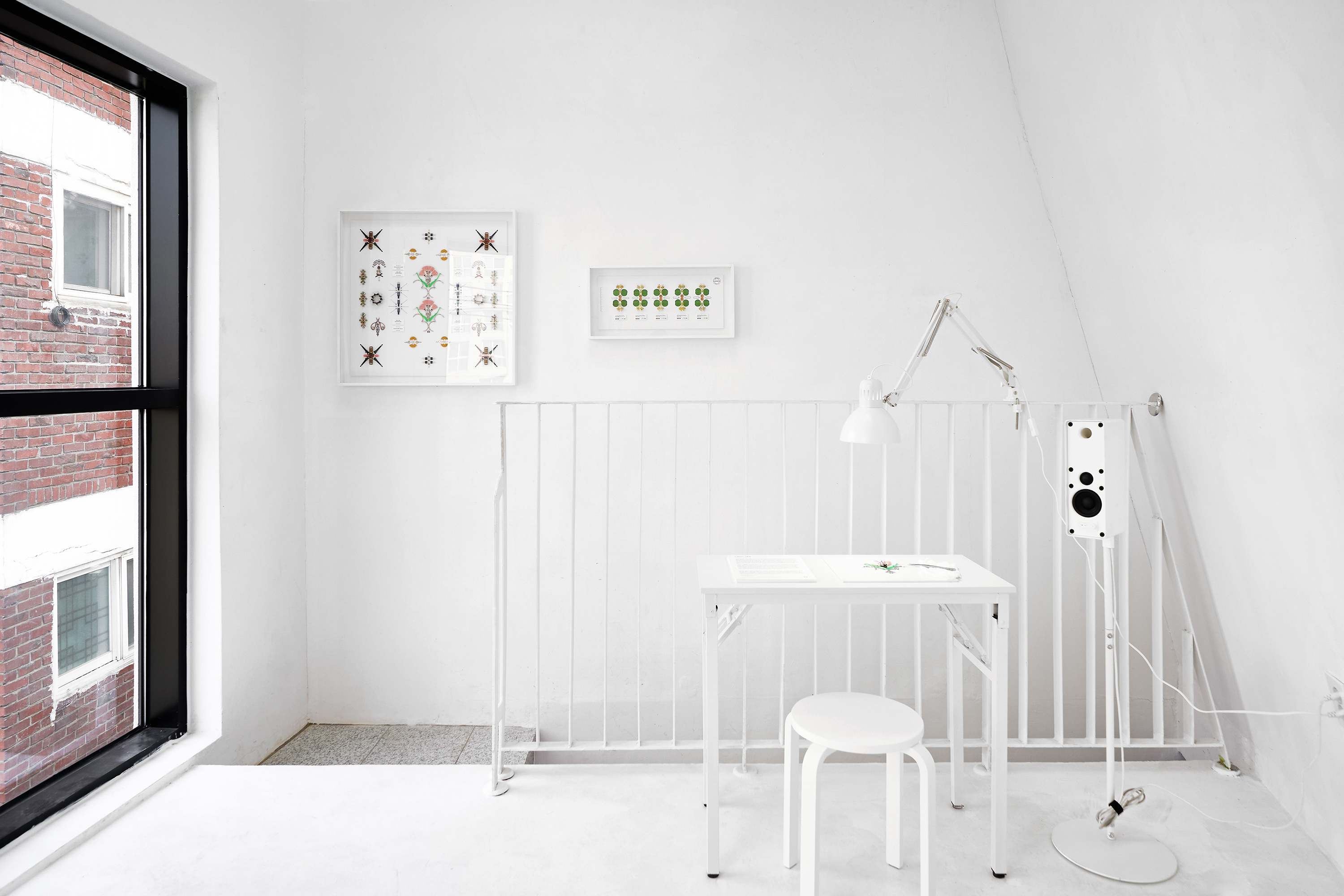


어둠이 내린 숲의 향 (2024)
The Scent of Navy Woods
The Scent of Navy Woods
《어둠이 내린 숲의 향》은 네덜란드 유학 시절 에인트호번의 Philips De Jongh 숲에서 경험한 일화로부터 시작된다.
‘…숲에 어둠은 순식간에 찾아왔다. 바람이 불자 숲의 검은 실루엣은 일제히 기괴한 소리를 내며 몸을 떨었다. 내게는 놀이터나 다름없던 낯익은 그곳이 한순간에 도망치고 싶은 미로로 변하였다. 하지만 어둠에 시야가 무뎌지자 비로소 포근한 흙 내음과 알싸한 풀 향기가 점점 진동했다. 숲의 향기는 내가 결코 다른 곳에 있지 않음을 이야기해 주었고 그 공포를 마주할 용기가 돼 주었다...’
익숙함이 낯섦으로 전복된 어둠이 내린 숲(Navy Woods)은 당연했던 것에 부자연스러움과 막연한 불안감을 느끼는 현대 사회를 투영한다. 어둠이 내린 Philips De Jongh 숲의 풍경을 재현한 설치 작품과 함께 공간을 가득 채우는 숲의 향은 관람객들을 일화 속의 주인공으로 초대하며 오늘날의 불안과 공포에 마주할 용기를 선물한다. 직접 촬영한 Philips De Jongh 숲의 사진을 어둠과 빛을 반전시키는 청사진법(Cyanotype)으로 인화하고 액자 구조로 배치해, 낯설고 기괴했던 어둠이 내린 숲의 풍경을 재현하였다. 공간에 미로처럼 놓인 액자 조각은 숲에서 느꼈던 공황에 대한 회상을 물질화하며 관람객들의 향에 대한 경험적 사유를 촉진한다. 동시에 햇빛에 반응하여 인화되는 청사진법으로 완성된 어둠이 내린 숲의 풍경은 실제로 수백 분의 햇살을 머금고 있으며 희망과 긍정의 미래를 암시한다.
-
‘The Scent of Navy Woods’ begins with an anecdote from the artist's time studying in the Netherlands, in the Philips De Jongh forest in Eindhoven.
"... Darkness fell upon the forest in an instant. The wind blew, making the black silhouettes of the trees shake with eerie sounds. What was once a familiar place suddenly became a maze I wanted to escape. But as my sight dulled, the soft scent of the earth and sharp fragrance of grass grew stronger. The forest’s scent assured me that I was truly nowhere else and gave me the courage to face my fear..."
The installation, recreating the darkened Philips De Jongh forest and filled with its scent, invites viewers to immerse themselves in the story and confront their own fears and uncertainties. Photographs taken in the forest were printed using cyanotype, which inverts light and dark, and arranged in frames scattered like a maze. This materializes the memory of panic and encourages reflection on scent. The cyanotype-printed landscape, infused with sunlight, hints at hope and a positive future.
본 작품은 오일 향 전문 브랜드 UNVANISH의 Foggy Hinoki Forest 향 프로모션 전시의 일환으로 제작되었습니다. This work was created as part of the promotional exhibition for the Foggy Hinoki Forest scent by the oil fragrance brand UNVANISH.
‘…숲에 어둠은 순식간에 찾아왔다. 바람이 불자 숲의 검은 실루엣은 일제히 기괴한 소리를 내며 몸을 떨었다. 내게는 놀이터나 다름없던 낯익은 그곳이 한순간에 도망치고 싶은 미로로 변하였다. 하지만 어둠에 시야가 무뎌지자 비로소 포근한 흙 내음과 알싸한 풀 향기가 점점 진동했다. 숲의 향기는 내가 결코 다른 곳에 있지 않음을 이야기해 주었고 그 공포를 마주할 용기가 돼 주었다...’
익숙함이 낯섦으로 전복된 어둠이 내린 숲(Navy Woods)은 당연했던 것에 부자연스러움과 막연한 불안감을 느끼는 현대 사회를 투영한다. 어둠이 내린 Philips De Jongh 숲의 풍경을 재현한 설치 작품과 함께 공간을 가득 채우는 숲의 향은 관람객들을 일화 속의 주인공으로 초대하며 오늘날의 불안과 공포에 마주할 용기를 선물한다. 직접 촬영한 Philips De Jongh 숲의 사진을 어둠과 빛을 반전시키는 청사진법(Cyanotype)으로 인화하고 액자 구조로 배치해, 낯설고 기괴했던 어둠이 내린 숲의 풍경을 재현하였다. 공간에 미로처럼 놓인 액자 조각은 숲에서 느꼈던 공황에 대한 회상을 물질화하며 관람객들의 향에 대한 경험적 사유를 촉진한다. 동시에 햇빛에 반응하여 인화되는 청사진법으로 완성된 어둠이 내린 숲의 풍경은 실제로 수백 분의 햇살을 머금고 있으며 희망과 긍정의 미래를 암시한다.
-
‘The Scent of Navy Woods’ begins with an anecdote from the artist's time studying in the Netherlands, in the Philips De Jongh forest in Eindhoven.
"... Darkness fell upon the forest in an instant. The wind blew, making the black silhouettes of the trees shake with eerie sounds. What was once a familiar place suddenly became a maze I wanted to escape. But as my sight dulled, the soft scent of the earth and sharp fragrance of grass grew stronger. The forest’s scent assured me that I was truly nowhere else and gave me the courage to face my fear..."
The installation, recreating the darkened Philips De Jongh forest and filled with its scent, invites viewers to immerse themselves in the story and confront their own fears and uncertainties. Photographs taken in the forest were printed using cyanotype, which inverts light and dark, and arranged in frames scattered like a maze. This materializes the memory of panic and encourages reflection on scent. The cyanotype-printed landscape, infused with sunlight, hints at hope and a positive future.
본 작품은 오일 향 전문 브랜드 UNVANISH의 Foggy Hinoki Forest 향 프로모션 전시의 일환으로 제작되었습니다. This work was created as part of the promotional exhibition for the Foggy Hinoki Forest scent by the oil fragrance brand UNVANISH.

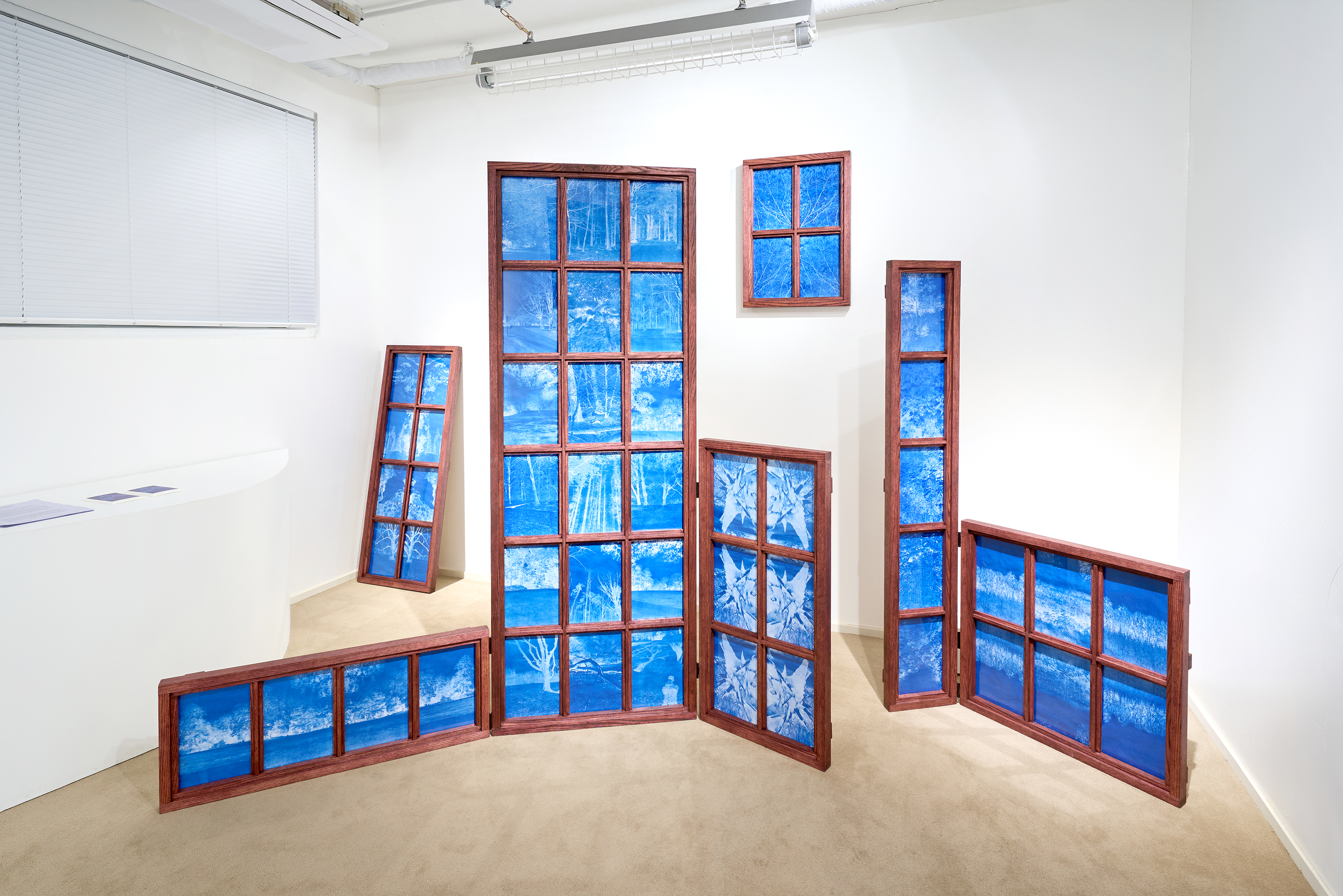
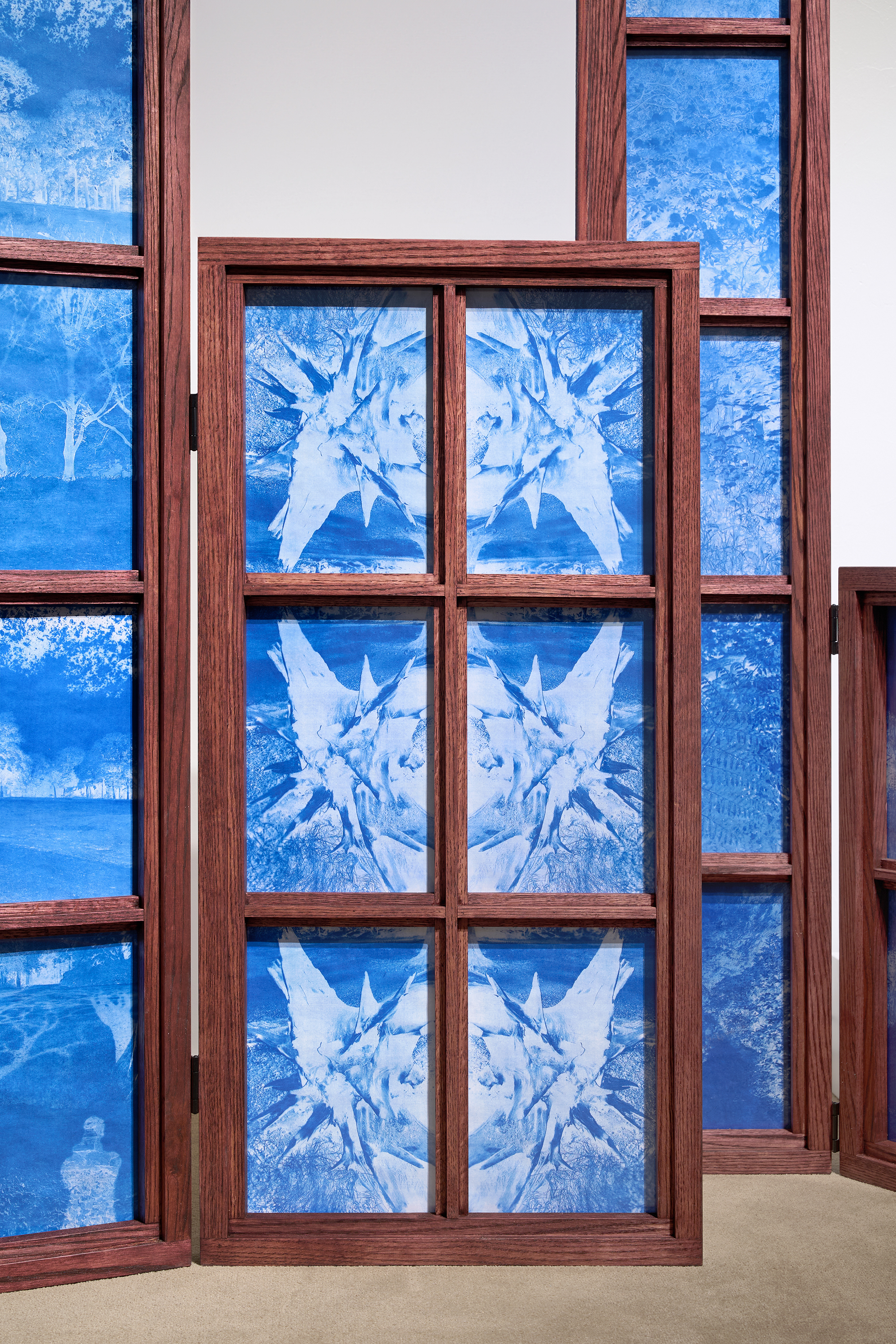




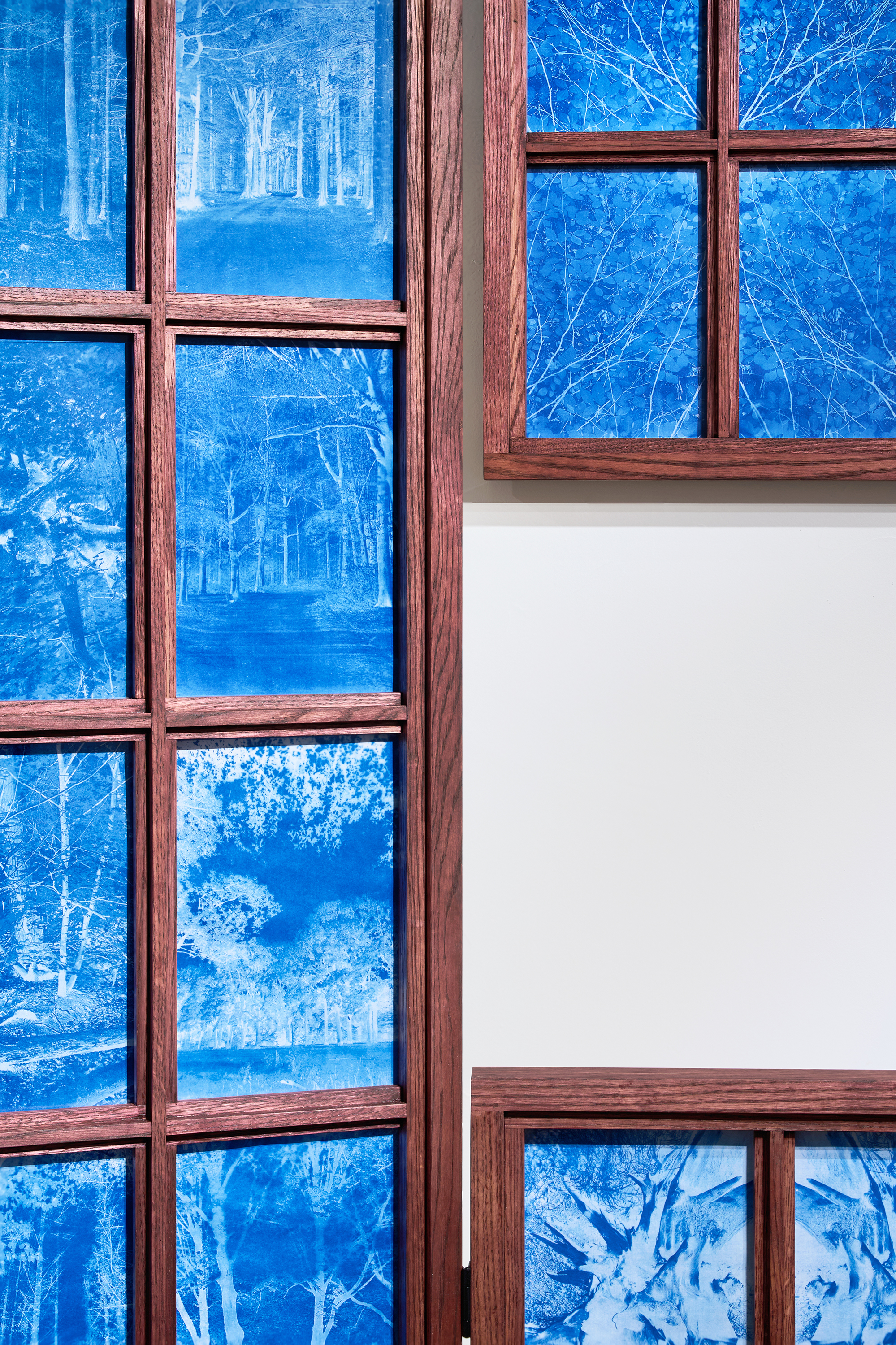


수상한 자연사 박물관 (2022)
Suspicious Museum of Natural History
Suspicious Museum of Natural History
<수상한 자연사 박물관>은 인간의 접근이 70년 동안 제한되어온 한국 비무장지대(DMZ) 생태계를 통해서 ‘손닿지 않은 자연(Untouched Nature)’이란 개념의 섬뜩한 기저구조를 드러내는 것을 목표로 한다.
역설적으로 한국 DMZ는 분단 아래의 잦은 군사 도발로 인하여 비무장지대라는 이름과 다르게 본래의 기능을 상실한 무기화된 국경지대가 되었다. DMZ를 점거한 200만 개의 미확인 지뢰와 100여 개의 무장 감시초소, 248km에 걸친 철조망은 항시 인간의 접근을 저항하고 있다. 인간의 출입을 위협하는 이러한 폭력적 객체들은 인간뿐만 아니라 DMZ에 서식하는 다른 생물종들에도 위협적일 것이다. 하지만 어떻게 오늘날 DMZ는 태백산맥과 함께 한반도의 핵심 생태 축으로 거듭날 수 있었을까. 지뢰에 부상당한 멧돼지와 검독수리는 DMZ가 폭력적인 분단 역사에 적응하며 새롭게 형성된 생태계임을 증명한다. DMZ의 서식종들은 안정적으로 현재의 삶을 지속하기 위해 오히려 DMZ를 점거한 폭력적 객체들을 필요로 할 것이다. 다시 말해 DMZ의 폭력적 객체들은 현 DMZ 생태계의 가장 필수적인 생태적 요소인 셈이다. 만약 이 요소 중 하나라도 사라지게 된다면 현재의 DMZ 생태계는 불안정화되고 연쇄적으로 붕괴할 것이다.
우리는 인간이 부재한 자연을 순수한 자연으로 인식하는 ‘손닿지 않은 자연’에 대한 환상을 가지고 있다. 하지만 폭력적인 분단 역사에 따라 탄생한 DMZ 생태계를 평화로운 자연 낙원으로 낭만화하는 현상은 ‘손닿지 않은 자연’이란 개념이 폭력에 의해 성취될 수 있음을 암시하며 이를 영속시키기 위해 그 폭력성이 정당화될 수 있음을 보여준다. 이에 대응하여 송승준은 DMZ의 폭력적 인프라와 공생하는 생물 다양성 아카이브와 그들의 서식지를 재현한 상상적 형태의 DMZ 생태계 디오라마를 제안한다. 그는 인간의 밀접한 관찰에 의해서만 수행되는 자연사 박물관의 문화적 트로프를 통해 인간의 부재로 형성된 DMZ 생태계를 풀이함으로써 관람객들에게 모순된 인간의 관점을 질문한다.
-
The ‘Suspicious Museum of Natural History’ aims to expose the unsettling foundation of the concept of ‘Untouched Nature’ through the ecosystem of the Korean Demilitarized Zone (DMZ), where human access has been restricted for nearly 70 years.
Ironically, despite its name, the Korean DMZ has become a militarized border zone due to frequent military provocations during the division, losing its original function. The 200 million unexploded landmines, over 100 armed guard posts, and 248km of barbed wire in the DMZ constantly resist human access. These violent infrastructures, while threatening to humans, also endanger the species inhabiting the zone. Yet paradoxically, the DMZ has emerged as one of the Korean Peninsula’s core ecological axis. Wild boars and golden eagles injured by landmines reveal that the DMZ’s ecosystem has evolved in direct response to its violent past. In fact, the species residing within may now depend on these very instruments of violence for their continued existence, making such objects essential components of the ecological system. Should even one of these elements disappear, the delicate balance of the ecosystem could unravel, triggering a cascading collapse.
We often romanticize “Untouched Nature” as pure and pristine, unspoiled by human presence. But the DMZ, born from the trauma of division, challenges this ideal. It suggests that such a notion of nature can in fact be forged through violence—and that violence can be justified in the name of preserving it. In response, Seungjoon Song proposes two speculative designs: a set of biodiversity data that coexists with the DMZ’s violent infrastructure, and an imaginative diorama reconstructing the habitats of these species. Through the cultural lens of the natural history museum, which relies on human observation, he challenges viewers to question the contradictory human perspective.
본 작업은 Design Academy Eindhoven(NL)의 MA Contextual Design Course, 2022 Graduation Project로 수행되었습니다. 'DMZ 생태계 디오라마'와 'DMZ 생태보고서 누락종' 두 개의 개별 프로젝트로 구성되어 있습니다. This work was part of the MA Contextual Design Course, 2022 Graduation Project at Design Academy Eindhoven (NL). It consists of two individual projects: ‘DMZ Ecosystem Diorama’ and ‘Missing Species in DMZ Ecology.’
역설적으로 한국 DMZ는 분단 아래의 잦은 군사 도발로 인하여 비무장지대라는 이름과 다르게 본래의 기능을 상실한 무기화된 국경지대가 되었다. DMZ를 점거한 200만 개의 미확인 지뢰와 100여 개의 무장 감시초소, 248km에 걸친 철조망은 항시 인간의 접근을 저항하고 있다. 인간의 출입을 위협하는 이러한 폭력적 객체들은 인간뿐만 아니라 DMZ에 서식하는 다른 생물종들에도 위협적일 것이다. 하지만 어떻게 오늘날 DMZ는 태백산맥과 함께 한반도의 핵심 생태 축으로 거듭날 수 있었을까. 지뢰에 부상당한 멧돼지와 검독수리는 DMZ가 폭력적인 분단 역사에 적응하며 새롭게 형성된 생태계임을 증명한다. DMZ의 서식종들은 안정적으로 현재의 삶을 지속하기 위해 오히려 DMZ를 점거한 폭력적 객체들을 필요로 할 것이다. 다시 말해 DMZ의 폭력적 객체들은 현 DMZ 생태계의 가장 필수적인 생태적 요소인 셈이다. 만약 이 요소 중 하나라도 사라지게 된다면 현재의 DMZ 생태계는 불안정화되고 연쇄적으로 붕괴할 것이다.
우리는 인간이 부재한 자연을 순수한 자연으로 인식하는 ‘손닿지 않은 자연’에 대한 환상을 가지고 있다. 하지만 폭력적인 분단 역사에 따라 탄생한 DMZ 생태계를 평화로운 자연 낙원으로 낭만화하는 현상은 ‘손닿지 않은 자연’이란 개념이 폭력에 의해 성취될 수 있음을 암시하며 이를 영속시키기 위해 그 폭력성이 정당화될 수 있음을 보여준다. 이에 대응하여 송승준은 DMZ의 폭력적 인프라와 공생하는 생물 다양성 아카이브와 그들의 서식지를 재현한 상상적 형태의 DMZ 생태계 디오라마를 제안한다. 그는 인간의 밀접한 관찰에 의해서만 수행되는 자연사 박물관의 문화적 트로프를 통해 인간의 부재로 형성된 DMZ 생태계를 풀이함으로써 관람객들에게 모순된 인간의 관점을 질문한다.
-
The ‘Suspicious Museum of Natural History’ aims to expose the unsettling foundation of the concept of ‘Untouched Nature’ through the ecosystem of the Korean Demilitarized Zone (DMZ), where human access has been restricted for nearly 70 years.
Ironically, despite its name, the Korean DMZ has become a militarized border zone due to frequent military provocations during the division, losing its original function. The 200 million unexploded landmines, over 100 armed guard posts, and 248km of barbed wire in the DMZ constantly resist human access. These violent infrastructures, while threatening to humans, also endanger the species inhabiting the zone. Yet paradoxically, the DMZ has emerged as one of the Korean Peninsula’s core ecological axis. Wild boars and golden eagles injured by landmines reveal that the DMZ’s ecosystem has evolved in direct response to its violent past. In fact, the species residing within may now depend on these very instruments of violence for their continued existence, making such objects essential components of the ecological system. Should even one of these elements disappear, the delicate balance of the ecosystem could unravel, triggering a cascading collapse.
We often romanticize “Untouched Nature” as pure and pristine, unspoiled by human presence. But the DMZ, born from the trauma of division, challenges this ideal. It suggests that such a notion of nature can in fact be forged through violence—and that violence can be justified in the name of preserving it. In response, Seungjoon Song proposes two speculative designs: a set of biodiversity data that coexists with the DMZ’s violent infrastructure, and an imaginative diorama reconstructing the habitats of these species. Through the cultural lens of the natural history museum, which relies on human observation, he challenges viewers to question the contradictory human perspective.
본 작업은 Design Academy Eindhoven(NL)의 MA Contextual Design Course, 2022 Graduation Project로 수행되었습니다. 'DMZ 생태계 디오라마'와 'DMZ 생태보고서 누락종' 두 개의 개별 프로젝트로 구성되어 있습니다. This work was part of the MA Contextual Design Course, 2022 Graduation Project at Design Academy Eindhoven (NL). It consists of two individual projects: ‘DMZ Ecosystem Diorama’ and ‘Missing Species in DMZ Ecology.’
